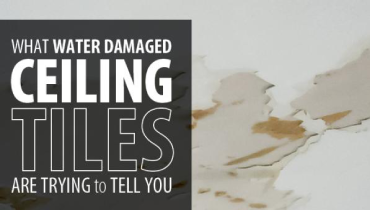
According to Rainbow Restoration, water-damaged ceiling tiles signal underlying issues that require prompt attention.
|
Annoying and unsightly, wet or stained ceiling tiles are a whisper of hidden problems. How can you locate the source before those problems start screaming at you in the form of major ceiling leaks, structural damage, and mold?
Determine What’s Causing the Water Stains
Stained ceiling tiles may indicate the presence of:
- Leaky HVAC components.
- A leak in the plumbing system, or worn pipe insulation leading to pooling condensation.
- Roof leaks from ice damming or worn roofing allowing rain inside.
- Leaks from water-using appliances such as hot water heaters, washing machines, refrigerators and dishwashers.
- Worn caulking allowing for water seepage around a shower pan on the floor above.
How to Repair Ceiling Tiles with Water Damage
Water stains on ceiling tile should only be cleaned once the source of the moisture has been identified and rectified. Otherwise your hard work will be for nothing.
- For severely damaged tiles:
Severe to moderately water damaged ceiling tiles should be disposed of and replaced with new, as mold and other illness-inducing contaminants can breed in effected tiles. Bad odors will also persist over such cosmetic fixes when replacement is warranted, and air quality can be negatively effected. - For cosmetic/surface damage:
- Bleach Method
Protect your floor with a drop cloth, removing any dust or debris from ceiling tiles with a vacuum brush or feather duster. Grab a ladder or step stool and don your safety glasses, and spray the effected tiles with a 50/50 solution of bleach and water. Wait 30 minutes or until the tile is dry, and repeat until the stain disappears. You can also apply the solution with a paint roller. Stained portion of your tile very small? You can also dip a Q-tip in 100% bleach for quick and easy application.
Tips: Clean ceiling tiles while they’re up, as they’re fragile and easily broken during removal and reinstallation. Don’t use too much solution, as too much moisture in the tile can cause sagging or cracks. - Paint Method
Toss a drop cloth on the floor, coat the tiles with stain-killing primer, then repaint. Without these special primers, the stain will simply bleed through your touch-up attempts.
- Bleach Method
Don’t Let it Go
Ignoring a water stain is the worst thing you can do, and will ultimately lead to severe structural damage, mold and poor indoor air quality. If you’re unsure about how to find the source of the leak, a professional handyman or home remediation specialist can help you, giving you an estimate of repair costs.
Drips dropping into your life? Schedule your complimentary repair estimate with the professionals at Rainbow Restoration® today.
